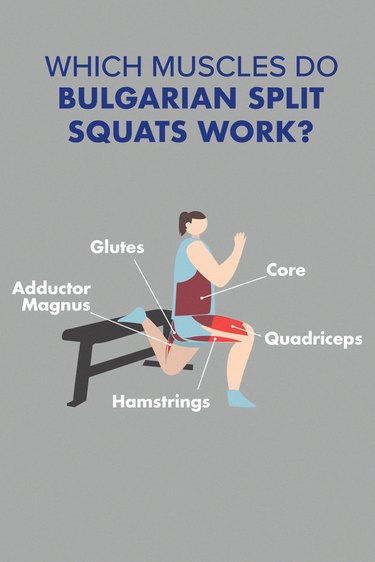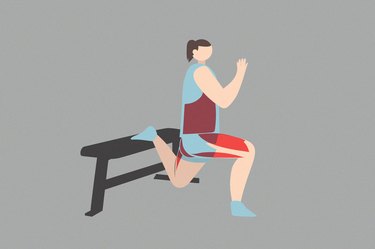

Bulgarian split squats — also known as rear foot–elevated split squats — are one of the best exercises for building lower-body strength and muscle. You can use them to target your quads, glutes, hips, hamstrings and core muscles.
Bulgarian split squats are a powerful exercise for achieving many different gym goals. You can load them with heavy weights and low reps to build strength or bump up the reps to build endurance. They're also a fantastic tool for improving athletic performance because they build the type of single-leg strength needed to run faster, jump higher and become more resilient.
Video of the Day
One reason why Bulgarian split squats are so effective is they work nearly every muscle in your lower body. They're a knee-dominant movement that primarily targets your quads and glutes, but your hamstrings, hips and core muscles also play important supporting roles. This helps build strength, stability and balance that translates to sport and daily life.
How to Do a Bulgarian Split Squat
Bulgarian Split Squat
- Stand a few feet in front of a bench, box or chair, facing away from it.
- Reach one foot back and place the top of your foot flat on the surface. To help with balance, widen your base of support by moving your left foot a few inches to the left.
- Lean your torso forward slightly and bend your front knee to sink your hips toward the floor as low as you can comfortably go.
- Your front-leg shin should be vertical or close to it, while your back knee should point down toward the floor. If either leg is out of place, move your front foot forward or backward until you’ve found the ideal positioning.
- Push through the middle of your front foot to return to standing.
- Repeat.
- Complete all reps on one leg before switching to the other.
Muscles Worked by the Bulgarian Split Squat
Quadriceps
The primary muscles used to perform Bulgarian split squats are the four muscles that make up your quadriceps on the front of your thigh:
- Rectus femoris
- Vastus lateralis
- Vastus intermedius
- Vastus medialis
These muscles are stretched as you descend into the bottom of your split squat and contract to propel you back up again.
It's important to note you're working your quads on both legs. Although it may seem like your elevated back leg isn't doing very much, it receives a larger stretch than your front leg and also helps push you out of the bottom of each rep.
Glutes
Your glutes are made of three muscles that serve different functions. The largest of these is the gluteus maximus. This muscle plays a primary role in Bulgarian split squats because it extends your hips at the top of each rep.
The gluteus medius is a smaller muscle located on the side of your hips. This muscle helps control the tracking of your knees when you perform single-leg exercises. Your gluteus medius performs a secondary role during Bulgarian split squats to help you keep your knees from caving in toward each other.
Quads vs. Glutes
Changing your body position can affect the degree to which a Bulgarian split squat works your quad muscles versus your glutes. If you want your quads to do more work, stay more upright during your Bulgarian split squats. You may also consider placing your front foot back slightly so there's more forward movement in your knees over your toes as you descend. You may also want to place a wedge under your front foot to hit your quads even harder.
To work your glutes more, lean forward slightly as you descend. This places a greater emphasis on your glutes because it moves your center of mass foward. You'll likely need to place your front foot farther out to give you more room to move. Be careful not to lean so far forward that you excessively round your back during the movement.
Adductor Magnus
The adductor magnus is a large, powerful hip muscle that runs from the lower part of your pelvis all the way down to your knee. This muscle plays an important role in many lower-body exercises, and the Bulgarian split squat is no exception. It assists in several jobs including controlling the position of your pelvis and extending your legs to rise to the top of the movement.
Hamstrings
Your quadriceps and hamstrings work in opposition to one another. Most exercises that primarily target the quadriceps rely on the hamstrings as an important secondary and stabilizing muscle group.
Your hamstrings contract on the back of your thigh as you lower yourself into the bottom of your split squat. During this portion of the rep, they assist your glute medius and other hip muscles to help you balance and keep your knee in the right position. At the top of your split squat, your hamstrings work with your glute maximus to help extend your hips.
Core Muscles
Although the Bulgarian split squat is primarily a lower-body exercise, your core muscles are involved in important ways.
Larger core muscles like your abdominals and obliques, as well as deeper core muscles like your transverse abdominis and erector spinae, work with your lower body and hip muscles to stabilize the position of your spine and pelvis. Your core contracts in order to stabilize you as you move to help you use good form.
How much weight you hold and where you hold it affects the degree to which your core muscles are activated during Bulgarian split squats. Holding weights in front of your body turns on your core muscles more than holding weights at your sides or on your back. Prioritize goblet, front rack and Zercher Bulgarian split squat variations if you want to increase core muscle activation.
Related Reading

Was this article helpful?
150 Characters Max
0/150
Thank you for sharing!
Thank you for your feedback!